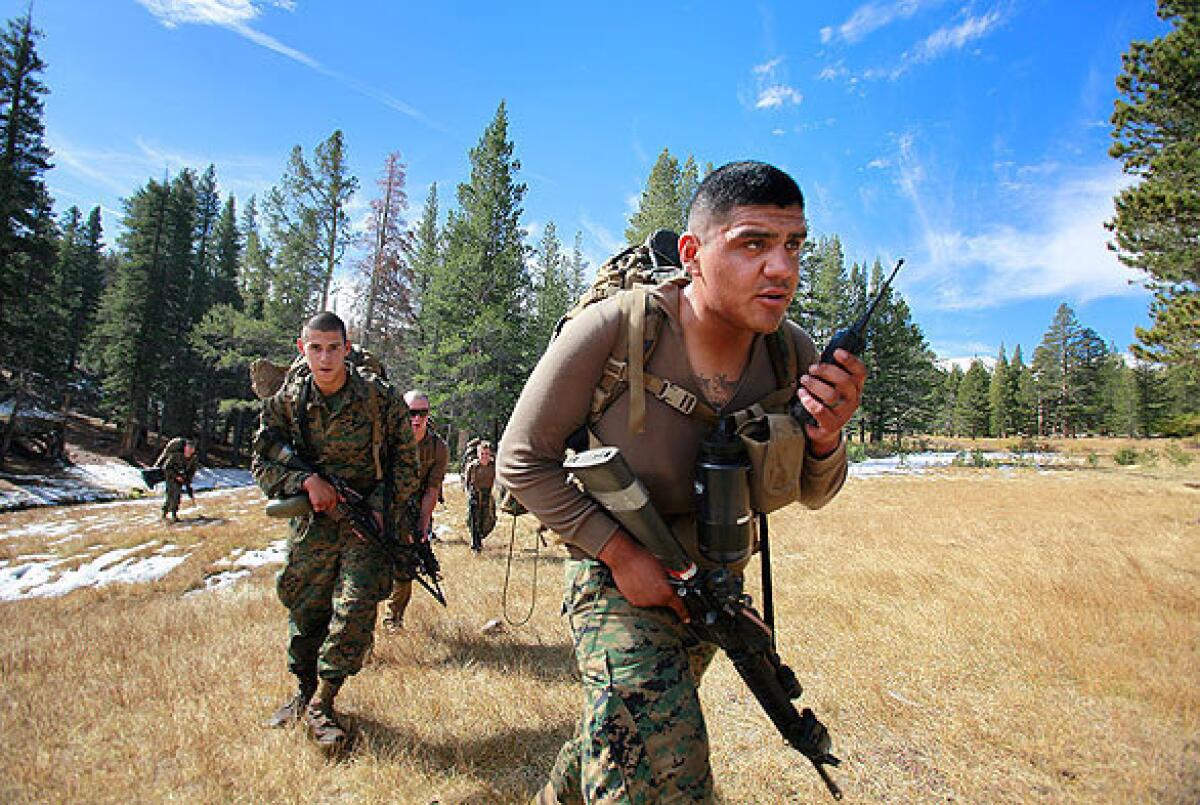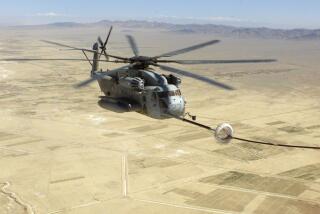A training ground as beautiful as the front lines are hellish

For thousands of U.S. Marines, the road to Afghanistan goes through an isolated training facility here in the Eastern Sierra where they share the rugged Humboldt-Toiyabe National Forest with civilian hunters, backpackers and skiers.
On a recent weekend, several hundred Marines were on an overnight march to test their land navigation, communication and outdoor survival skills. As they returned to base camp Sunday morning, hunters dressed in orange vests were driving their four-wheel-drive vehicles up the mountain in hopes of bagging deer.
The two groups exchanged courteous waves: one using the mountains to train for war, the other for weekend recreation.
Col. Norman Cooling, an Iraq and Afghanistan combat veteran who runs the Marine Corps Mountain Warfare Training Center here, notes with some amusement an oddity in the Pentagon’s agreement with the U.S. Forest Service: Civilian hunters can use live ammunition but Marines, except in designated ranges, are restricted to blanks.
In the last year, 13,541 Marines, sailors and foreign troops have trained at Bridgeport, an increase of 238% over the previous year. More increases are expected.
As the U.S. military trains to fight at medium and high altitudes in Afghanistan and other potential hot spots, “no other military venue in the nation can replicate these conditions better than here in the Eastern Sierra,” Cooling said.
Marines train on 46,000 mountainous acres owned by the federal government, 20 miles outside Bridgeport (population 900) just north of the Yosemite Valley -- all set in a postcard-beautiful region of tall trees, the fast-moving Walker River, thick winter snow and terrain favored by deer, bear and cougars.
California 108 runs past the training center’s buildings in Pickel Meadow to the Sonora Pass, at 9,624 feet, the second-highest highway pass through the Sierra. In the spring and early summer, the meadow and mountain slopes are brilliant green; in fall the aspens turn golden and then bright orange.
The Marine Corps has had a training center here since the Korean War, but the war in Afghanistan, with its mountains and spread-out population, has given the remote facility a new significance.
Marine Staff Sgt. Thomas Davis will soon be in Afghanistan, working with rural villagers to win their support for the U.S.-led war against the Taliban. Gunnery Sgt. Brad Lenox will be building “expeditionary airfields,” allowing the U.S. to quickly move troops and supplies in a region with few roads. And Sgt. Nicholas Heier’s engineering battalion could be in Afghanistan to provide “sustainability, mobility and counter-mobility,” which includes hunting for roadside bombs before they can kill U.S. troops.
“You can’t get this terrain anywhere else,” said Heier, whose battalion is based at Camp Pendleton.
Bridgeport is meant to prepare Marines for Afghanistan’s cold, snowy winters; rugged landscape where communication is difficult; and high altitudes where breathing is labored and the trajectory of bullets is difficult to gauge. To enhance the realism, various areas are given names meant to sound Afghan.
“If you can move, shoot and communicate in the mountains, you can do it anywhere,” said Maj. Urbano Cruz, the officer in charge of training.
The Marine Corps has expanded training eastward beyond the national forest into flatlands controlled by the Bureau of Land Management. A 68-mile overland convoy route through Lucky Boy Pass to the Army depot in Hawthorne, Nev., prepares Marines for the roadside bombs and sniper attacks they are likely to encounter in Afghanistan.
At Bridgeport, Marines receive instruction in avalanche survival, cold-weather medicine, the use of donkeys and mules as pack animals and how to adjust for thin air and tricky winds when aiming a sniper shot. There are live-fire ranges -- away from the areas where civilians are permitted.
Many of the courses are for small groups of Marines selected by their superiors. Others are for companies of 100 Marines or more.
Eight times a year, entire battalions (each with 800 to 1,200 Marines) come to Bridgeport for a 21-day exercise called Mountain Warrior. In the winter, two days are added for snowshoe instruction.
The Dutch and British military send troops to Bridgeport for training.
Davis is part of the 4th Civil Affairs Group, reservists based in Washington, D.C., who will be assigned to work in Helmand province, a Taliban stronghold.
The Bridgeport curriculum includes Afghan emigres playing the part of villagers, some friendly, some hostile, many incredulous. Faux villages are set up to add to the realism, although Forest Service rules dictate the structures can be left up for only a few days at a time.
Many of the Marines from the 4th Civil Affairs Group are veterans of similar missions in Iraq. Afghanistan will be more difficult, they agreed. Bridgeport “allows our Marines to see how tough it can be,” said the group’s commander, Lt. Col. Martin Croxton.
Croxton’s Marines are also toughening up so they can match the infantry Marines step for step when they travel into the hinterlands of Afghanistan. In Marine culture, infantry “grunts” are slow to accept outsiders.
They have to trust us,” said Davis, 42. “If we’re not properly trained, we’ll be considered a liability and they’ll leave us in the rear.”
Lenox and 60 other Marines from Marine Corps Air Station Miramar in San Diego have been working for weeks to replace the current landing pad at the Pickel Meadow portion of the center, at an altitude of 6,800 feet.
“Everything we’re doing here, we’ll be doing in Afghanistan,” said Lenox, 33.
Unlike the civil affairs group and the Marines from Miramar, the engineering battalion has yet to receive its orders. The battalion is awaiting a decision from the White House about U.S. strategy in Afghanistan.
“I’m ready to go wherever the president wants,” said Pfc. Christopher Clausen, 19. “I’ve been to Bridgeport.”
More to Read
Start your day right
Sign up for Essential California for news, features and recommendations from the L.A. Times and beyond in your inbox six days a week.
You may occasionally receive promotional content from the Los Angeles Times.






